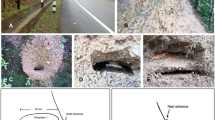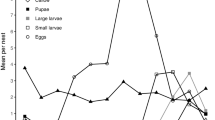Summary
Observations of inter- and intraseasonal dispersal patterns in the primitively social sweat bee Halictus rubicundus in New York reveal considerable philopatry in both sexes. Females overwinter away from the nest aggregation, in diapause for 8–11 months, and return to dig new nests close to the site of their natal nests (typically within 50 cm). Nests are all founded by siggle females (haplometrosis). Clumping of nests may reflect patterns of soil vegetation. Workers rarely enter or take up residence in non-natal nests. Males commonly return to both natal and non-natal nests, and actively patrol vegetation near the natal aggregation for females. These philopatric tendencies, in combination with the haplometrotic mode of nest founding, should have important effects on population structure, particularly in terms of population subdivision, mate choice, and intracolony interactions. The resulting population structure may be conducive to the evolution and maintenance of social behavior.
Similar content being viewed by others
References
Alexander RD, Sherman PW (1977) Local mate competition and parental investment in social insects. Science 196:494–500
Barrows EM (1976) Mating behavior in halictine bees (Hymenoptera: Halictidae): I, patrolling and age-specific behavior in males. J Kans Entomol Soc 49:105–119
Bateson PPG (1983) Optimal outbreeding. In: Bateson PPG (ed) Mate choice. Cambridge University Press, Cambridge, pp 367–377
Breed MD (1976) The evolution of social behavior in primitively social bees: a multivariate analysis. Evolution 30:234–240
Brockmann HJ (1984) The evolution of social behaviour in insects. In: Krebs JR, Davies NB (eds) Behavioural ecology: an evolutionary approach, 2nd edn. Sinauer, Massachusetts, pp 340–361
Crozier RH, Page RE (1985) On being the right size: male contributions and multiple mating in social Hymenoptera. Behav Ecol Sociobiol 18:105–115
Crozier RH, Smith BH, Crozier YC (1987) Relatedness and population structure of the primitively eusocial bee Lasioglossum zephyrum (Hymenoptera: Halictidae) in Kansas. Evolution 41:902–910
Greenberg L (1982) Persistent habituation to female odor by male sweat bees Lasioglossum zephyrum (Hymenoptera: Halictidae). J Kans Entomol Soc 55:525–531
Hamilton WD (1972) Altruism and related phenomena, mainly in social insects. Annu Rev Ecol Syst 3:193–232
Klahn JE (1979) Philopatric and nonphilopatric foundress associations in the social wasp Polistes fuscatus. Behav Ecol Sociobiol 5:417–424
Kukuk PF (1989a) Evolutionary genetics of a primitively eusocial halictine bee, Dialictus zephyrus. In: Breed MD, Page RE (eds) The genetics of social evolution. Westview, Colorado, pp 183–202
Kukuk PF (1989b) Dispersal of males of the primitively eusocial sweat bee Dialictus zephyrus within a small nest aggregation. Sociobiology 15:1–9
Kukuk PF, Decelles PC (1986) Behavioral evidence for population structure in Lasioglossum (Dialictus) zephyrum female dispersion patterns. Behav Ecol Sociobiol 19:233–239
Kukuk PF, Eickwort GC, May B (1987) Multiple maternity and multiple paternity in first generation brood from single foundress colonies of the sweat bee Dialictus zephyrus (Hymenoptera: Halictidae). Insectes Soc 34:131–135
Lin N, Michener CD (1972) Evolution of sociality in insects. Q Rev Biol 47:131–159
Malyshev S (1935) The nesting habits of solitary bees. A comparative study. Eos 11:201–309
Michener CD, Lange RB, Bigarella JJ, Salamuni R (1958) Factors influencing the distribution of bees' nests in earth banks. Ecology 39:207–217
Michod RE (1982) The theory of kin selection. Annu Rev Ecol Syst 13:23–55
Noonan KM (1981) Individual strategies of inclusive-fitness-maximizing in Polistes fuscatus foundresses. In: Alexander RD, Tinkle DW (eds) Natural selection and social behavior: research and theory. Chiron Press, New York, pp 18–44
Packer L (1986) Multiple-foundress associations in a temperate population of Halictus ligatus (Hymenoptera; Halictidae). Can J Zool 64:2325–2332
Packer L, Knerer G (1985) Social evolution and its correlates in bees of the subgenus Evylaeus (Hymenoptera; Halictidae). Behav Ecol Sociobiol 17:143–149
Packer L, Knerer G (1986) An analysis of variation in the nest architecture of Halictus ligatus in Ontario. Insectes Soc 33:190–205
Poole RW (1974) An introduction to quantitative ecology. McGraw Hill, New York, pp 116–118
Roberts RB (1973) Bees of Northwestern America: Halictus (Hymenoptera: Halictidae). Oreg State Univ Agri Exp St Tech Bull 126:1–23
Sakagami SF, Fukuda H (1972) Life of a Japanese eusocial halictine bee, Lasiglossum duplex, out of brood rearing season (Hymenoptera, Halictidae). Insectes Soc 19:137–152
Sakagami SF, Hoshikawa K, Fukuda H (1984) Overwintering ecology of two social halictine bees, Lasioglossum duplex and L. problematicum. Res Popul Ecol 26:363–378
Shields WM (1982) Philopatry, inbreeding, and the evolution of sex. SUNY Press, Albany
Smith BH, Ayasse M (1987) Kin-based male mating preferences in two species of halictine bee. Behav Ecol Sociobiol 20: 313–318
Sokal RR, Rohlf FJ (1981) Biometry, 2nd edn. Freeman, San Francisco
Stöckhert E (1923) Über Entwicklung und Lebensweise der Bienengattung Halictus Latr. und ihrer Schmarotzer (Hym.). Konowia 2:48–64, 146–165, 216–247
Wade MJ (1980) An experimental study of kin selection. Evolution 34:844–855
Wade MJ, Breden F (1981) The effect of inbreeding on the evolution of altruistic behavior by kin selection. Evolution 35:844–858
Wcislo WT (1987) The role of learning in the mating biology of a sweat bee Lasioglossum zephyrum (Hymenoptera: Halictidae). Behav Ecol Sociobiol 20:179–185
West-Eberhard MJ (1978) Polygyny and the evolution of social behavior in wasps. J Kans Entomol Soc 51:832–856
Wilson DS (1983) The group selection controversy: history and current status. Annu Rev Ecol Syst 14:159–187
Yanega D (1988) Social plasticity and early-diapausing females in a primitively social bee. Proc Natl Acad Sci USA 85:4374–4377
Yanega D (1989) Caste determination and differential diapause within the first brood of Halictus rubicundus in New York. Behav Ecol Sociobiol 24:97–107
Author information
Authors and Affiliations
Rights and permissions
About this article
Cite this article
Yanega, D. Philopatry and nest founding in a primitively social bee, Halictus rubicundus . Behav Ecol Sociobiol 27, 37–42 (1990). https://doi.org/10.1007/BF00183311
Received:
Accepted:
Issue Date:
DOI: https://doi.org/10.1007/BF00183311




